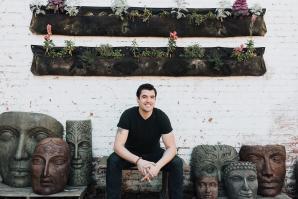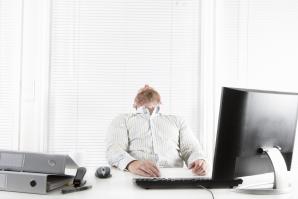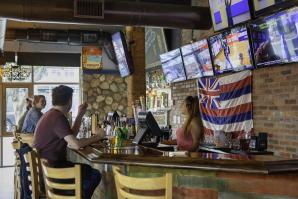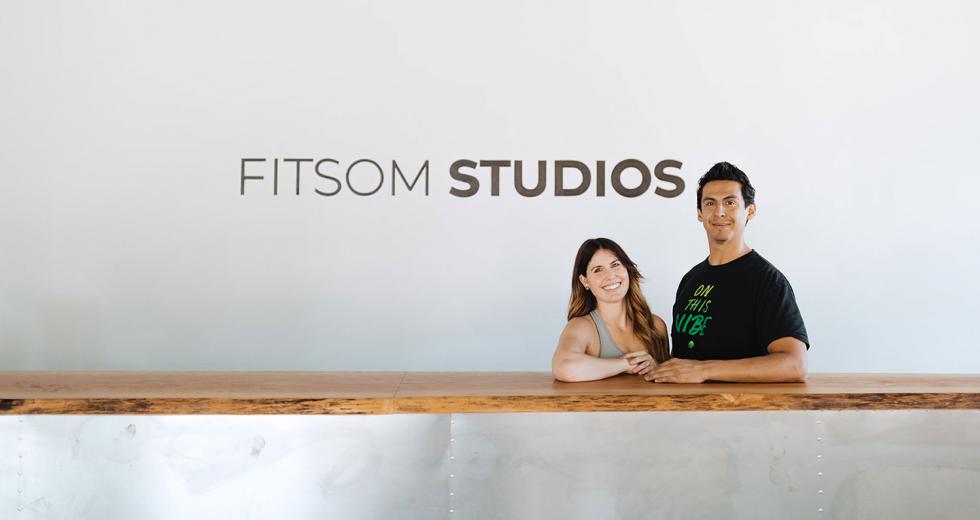If you walked into the Sacramento studio Fitsom Studios this time last year, you would see all the familiar markings of a gym: weights, mats, exercise balls, people huffing and puffing. Walk in there now (OK, you can’t actually walk in anymore because of the coronavirus), and the bright, open space houses an infrared sauna, an ice bath for cold plunge therapy, and bodywork tables with theracanes for working out knots and kinks.
That’s because cofounders Marco Guizar and Katelyn O’Neil shifted their business model from fitness to pain and stress management in September 2019. In a culture where sitting and anxiety are part of daily life, the husband-and-wife team found that modalities like breathing techniques and myofascial massage were more valuable and relevant. Rather than addressing one’s symptoms, the team of six employees believes in getting to the root cause — and in helping clients feel good.
Click here for more coronavirus coverage
A former marine, Guizar draws from his experience in high pressure situations and leadership. Starting Fitsom from his garage in 2009, he expanded to a studio in the Curtis Park neighborhood where he leads the studio management, marketing and education. O’Neil brings her bachelor’s degree in nutrition and food, plus a background in community building, to establish supportive relationships and experiences for clients. She is also a former educator for Lululemon and the Sacramento Natural Foods Co-op.
Fitsom’s philosophy of empowering and teaching clientele the skills and language for treating their own minds and bodies came in handy when, over the last month, businesses were forced to go virtual or, in some cases, shutter their doors permanently due to the coronavirus pandemic. The team may have physically closed their doors, but inside the 4,700-square-foot studio, Fitsom instructors and facilitators continue to treat clients old and new with virtual one-on-one sessions and self-paced learning modules.
Read on for how their approach to stress management is hyper-relevant in these uncertain times, and how they’ve shifted to serving clients entirely online:
How I describe what I do: Marco: We help people feel good again. We’ve been here (for) nine years. We started off as a gym, and over the time of being a gym, we realized that people were so tight, they were so stiff. So we switched it up into what we thought was the best thing for our clients. At the end of the day, we saw our clients were in pain. A lot of people out there right now, according to the (U.S. Centers for Disease Control), one in three Americans — are in chronic pain. So that’s what we do. We focus in on chronic pain, stress and anxiety.
The challenge of transitioning our entire business model from gym to pain and anxiety treatment: Marco: I think because we were a gym, when (our clients) originally came to us, they wanted fitness. They wanted to sweat and it was like cringey for us. … We explained to them, listen, we do fitness, but we are here more for your longevity … and we’re going to open up your stomach. And then like clockwork that, you know, we were in there a couple of weeks and they need months and months of work, but they’ve been in a couple of weeks. I’m like, when am I going to sweat when I’m not sore? … We got to the point where it was unethical on our end to continue to run a fitness business when we knew that there was so much more for our clients.
We lost all of our clients! But we got all new clients, and they’re just incredible. They’re exactly who we were speaking to, and it was 100 percent worth it.
Fitsom Studios quickly shifted its offerings to be available as
virtual sessions and online courses. (Photo by Nicolette
Lovell/courtesy of Fitsom Studios)

How doing this work helped me with the birthing process and life in general: Katelyn:For me (after having two home births), it wasn’t the fitness that was really helping me. I was a mom, postpartum, just felt really overwhelmed. And it wasn’t the fitness, the sweating of my body, that was helping me mentally. It wasn’t helping me as a business owner or becoming a better mom.
It was really all this other stuff that we were teaching in our classes. It was the breathing, Wim Hof (breathing exercises), deep bodywork, learning how to just get all these knots in this tension out of our body. That’s what really helped me. That’s what helped me have a better second home birth where it was a lot easier. My body was a lot more open. I wasn’t so full of tension. Doing that stuff and learning how to breathe and learning how to really tap into my parasympathetic nervous system really, really helped me just navigate life a little bit easier.
How we built our business model on self-empowerment: Marco: There really is no other way to do it (than empowering clients to do the work themselves). And that’s really the problem that we have out there in the wellness industry, is that people are dependent on practitioners. They’re dependent on their chiropractors and acupuncturists on their whatever. Right? We’re trying to break that dependency because I cannot see you enough. Most people have so much work to do. Like, how are people going to afford that? You know, you’re going to pay 10 grand, 20 grand? Because people need $20,000 worth of work at $100 an hour. You know? And that’s just the truth.
Very few people have that type of money, right? And that’s what we realized here at Fitsom. We know this. The only ethical way to do this is to teach them how to work on themselves. And that’s what we do.
My favorite form of stress and anxiety relief: Marco:Many people don’t know about their psoas muscle. Deep inside of your stomach, you have a big hip flexor called the psoas. It’s attached into your spine, and it goes all the way down deep inside of your inner legs, right into your groin. It’s really hardwired into your stress response. When someone’s really stressed out, their psoas tightens up. It’s just science. So if you’re going to ask us both, we’re going to have the same answer. psoas.
How our business has changed since coronavirus, and the services we’re offering virtually: Marco: I think we’re in a very unique position — although we are in a brick and mortar — I think the real value is our knowledge that we’ve accumulated over the last eight, nine years. And so it’s the work, it’s the knowledge that we’re really selling here. So we’ve taken this opportunity and closed our doors, and we filmed four days … and we’re putting all of this online in courses and offering virtual sessions via Zoom. So people can take advantage of the one-on-one attention. We’ve already performed (about) 20 zoom sessions, and they’ve been wonderful and, I think they have a tremendous amount of value. Even though it is on a computer, there’s so much bodywork you can do to yourself.
How we pivoted and adapted to “the new normal” so quickly: Marco: It’s always been our dream to (go virtual). When we saw that businesses were closing down, we got together as a team and we said, ‘OK, we’re going to quarantine as a team. We’re going to shut it down.’ We called all of our clients, we told them what was going on. And then we just put all of this on hyperspeed and just locked ourselves in here. If you literally look at our website, there’s nothing on there about brick and mortar and those services. It’s all shifted online within like five days.
I was in the Marine Corps, and I’ve been to war. So I think that I really keep it together in these really high stress environments. So it was a good pivot for us. I just really needed to make sure the team felt comfortable. But, yeah, it was, it would literally turn within 20 minutes when me and Kaitlin decided what we were going to do. We just wrote out the plan and then we turned to the team and everybody got on board really fast. And we were off and running in about probably 30 minutes after we made the decision.
Our advice to business owners who are tasked with shifting their business model post-coronavirus: Katelyn: We feel like a lot of people are waiting, like, we’re going to get back up and running in the next two weeks. Like, not gonna happen, right?
Marco: Yeah, I’ll say why this is working for us. We tried and failed at this for so many years: like video, graphic design, copywriting, website building. And you have to hire all these people. The problem is that now all these business owners are dependent on outside people. And that can’t happen in 2020. The core team of the business needs to have the skillset in 2020 and beyond. Even after we all get back up and running. … The only reason that we’re not afraid, and we feel like we’re going to flourish in this is because we possess these skills internally. We have cameras, we have computers, we have microphones for podcasts.
Katelyn:And a growth mindset.
Marco: Yeah, a growth mindset and all of these things are going to get us through. Before, but especially now. If you don’t know how to get on Instagram ads, if you don’t know how to generate traffic, what are you going to do?
–
Stay up to date on the effects of the coronavirus on people and business in the Capital Region: Subscribe to the Comstock’s newsletter today.
Recommended For You

Getting to Know: Micah Kearns
Meet the man behind the Sacramento chapter of a global speaker series devoted to making mistakes
Micah Kearns is no stranger to mistakes, failures, snafus or rock bottoms. Life experience, along with a gentle demeanor that suggests he is the physical embodiment of a “safe space,” make him quite the fit as chapter organizer of F—up Nights Sacramento.

Death by Desk Chair
How to combat our national sitting epidemic
Those long hours you’re logging at your desk may be taking a physiological toll that your morning run and bike commute can’t quite undo. We’re in the midst of a sitting epidemic that comes with some pretty scary health implications, but a simple change in our corporate culture might hold the key to better fitness for us all.

Local Businesses Struggle as Coronavirus Changes Our Daily Lives
On a bleary Monday morning in Sacramento with the Dow Jones industrial average tanking, on its way to a 2,997 point drop and its worst day since 1987, Greater Sacramento Economic Council President and CEO Barry Broome offered advice for local business owners that he knows won’t be popular.



